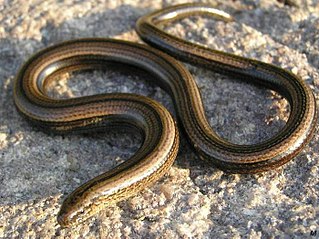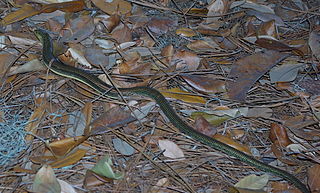
The Lacertidae are the family of the wall lizards, true lizards, or sometimes simply lacertas, which are native to Afro-Eurasia. It is a diverse family with at about 360 species in 39 genera. They represent the dominant group of reptiles found in Europe.

Anguidae refers to a large and diverse family of lizards native to the Northern Hemisphere. Common characteristics of this group include a reduced supratemporal arch, striations on the medial faces of tooth crowns, osteoderms, and a lateral fold in the skin of most taxa. The group is divided into two living subfamilies, the legless Anguinae, which contains slow worms and glass lizards, among others, found across the Northern Hemisphere, and Gerrhonotinae, which contains the alligator lizards, native to North and Central America. The family Diploglossidae was also formerly included. The family contains about 87 species in 8 genera.

Slowworms are a small genus (Anguis) of snake-like legless lizards in the family Anguidae. The genus has several living species, including the common slowworm, the eastern slowworm, the Greek slowworm, the Peloponnese slowworm, and the Italian slowworm. There are also known fossil species.

Ophisaurus is a genus of superficially snake-like legless lizards in the subfamily Anguinae. Known as joint snakes, glass snakes, or glass lizards, they are so-named because their tails are easily broken; like many lizards, they have the ability to deter predation by dropping off part of the tail, which can break into several pieces, like glass. The tail remains mobile, distracting the predator, while the lizard becomes motionless, allowing eventual escape. This serious loss of body mass requires a considerable effort to replace, and can take years to do so. Despite this ability, the new tail is usually smaller than the original.

The sheltopusik, also commonly called Pallas's glass lizard, the European legless lizard, or the European glass lizard, is a species of large glass lizard found from Southern Europe to Central Asia.

Anguinae is a subfamily of legless lizards in the family Anguidae, commonly called glass lizards, glass snakes or slow worms. The first two names come from the fact their tails easily break or snap off. Members of Anguinae are native to North America, Europe, Asia, and North Africa.

Paleontology or palaeontology is the study of prehistoric life forms on Earth through the examination of plant and animal fossils. This includes the study of body fossils, tracks (ichnites), burrows, cast-off parts, fossilised feces (coprolites), palynomorphs and chemical residues. Because humans have encountered fossils for millennia, paleontology has a long history both before and after becoming formalized as a science. This article records significant discoveries and events related to paleontology that occurred or were published in the year 2008.

Lazarussuchus is an extinct genus of amphibious reptile, known from the Cenozoic of Europe. It is the youngest known member of Choristodera, an extinct order of aquatic reptiles that first appeared in the Middle Jurassic. Fossils have been found in Late Paleocene, Late Oligocene, Early Miocene and possibly Late Miocene deposits in France, Germany, and the Czech Republic. Two species have been named: the type species L. inexpectatus ("unexpected") from the late Oligocene of France. and L. dvoraki from the early Miocene of the Czech Republic. It was not a large animal; with the total preserved body and tail length of L. inexpectatus being just over 30 centimetres. A complete specimen of Lazarussuchus with preserved soft tissue was found from the Late Paleocene of France, but has not been assigned to a species.
Paleontology or palaeontology is the study of prehistoric life forms on Earth through the examination of plant and animal fossils. This includes the study of body fossils, tracks (ichnites), burrows, cast-off parts, fossilised feces (coprolites), palynomorphs and chemical residues. Because humans have encountered fossils for millennia, paleontology has a long history both before and after becoming formalized as a science. This article records significant discoveries and events related to paleontology that occurred or were published in the year 2010.
Headonhillia is an extinct genus of anguine lizard which existed in England during the Eocene epoch. It was first named by Jozef Klembara and Bryony Green in 2010, and represents one of the smallest anguines currently known. The type species is Headonhillia parva. Fossils have been found in the Hampshire Basin.
Paleontology or palaeontology is the study of prehistoric life forms on Earth through the examination of plant and animal fossils. This includes the study of body fossils, tracks (ichnites), burrows, cast-off parts, fossilised feces (coprolites), palynomorphs and chemical residues. Because humans have encountered fossils for millennia, paleontology has a long history both before and after becoming formalized as a science. This article records significant discoveries and events related to paleontology that occurred or were published in the year 2012.

Shinisauria is a clade or evolutionary grouping of anguimorph lizards that includes the living Chinese crocodile lizard Shinisaurus and several of its closest extinct relatives. Shinisauria was named in 2008 by Jack Lee Conrad as a stem-based taxon to include all anguimorphs more closely related to Shinisaurus than to Anguis fragilis, Heloderma suspectum or Varanus varius. Several recent phylogenetic analyses of lizard evolutionary relationships place Shinisauria in a basal position within the clade Platynota, which also includes monitor lizards, helodermatids, and the extinct mosasaurs. Shinisaurians were once thought to be closely related to the genus Xenosaurus, but they are now considered distant relatives within Anguimorpha. The fossil record of shinisaurians extends back to the Early Cretaceous with Dalinghosaurus, which is from the Aptian aged Yixian Formation of China. Two other extinct shinisaurians are currently known: Bahndwivici from the Eocene of Wyoming and Merkurosaurus from the Late Oligocene of Germany and the Early Miocene of the Czech Republic. An indeterminate shinisaurian is known from an isolated tail found in the Eocene aged Messel pit in Germany.
Paleontology or palaeontology is the study of prehistoric life forms on Earth through the examination of plant and animal fossils. This includes the study of body fossils, tracks (ichnites), burrows, cast-off parts, fossilised feces (coprolites), palynomorphs and chemical residues. Because humans have encountered fossils for millennia, paleontology has a long history both before and after becoming formalized as a science. This article records significant discoveries and events related to paleontology that occurred or were published in the year 2018.
This list of fossil reptiles described in 2019 is a list of new taxa of fossil reptiles that were described during the year 2019, as well as other significant discoveries and events related to reptile paleontology that occurred in 2019.
Merkurosaurus is an extinct genus of lizards from the Shinisauria that is known from the Late Oligocene of Germany, collected in 1999, and the Early Miocene Most Formation of the Czech Republic and the Wiesbaden Formation Germany of (Amöneburg). A single species, Merkurosaurus ornatus, is known and was named and described by Jozef Klembara in 2008 based on the holotype Pb 02045 and other referred specimens. It was initially only known from deposits in the Czech Republic but remains found in Germany were eventually attributed to the genus in 2015.

The Hammerschmiede clay pit is a fossil bearing locality in Pforzen, Bavaria, Germany most well known for the discovery of Danuvius guggenmosi, the potentially earliest known bipedal ape. With an age of 11.66-11.42 Ma the site dates to the transition between the Middle and Late Miocene epoch, providing an important window into the faunal changes taking place during this time. This correlates to the time just after the Serravallian-Tortonian boundary, and the MN zones 7/8. It is one of the most well-known Miocene sites, with over 15,000 individual fossils and 117 species having been discovered as of 2020. It has been called "the most important German paleontological discovery of the last decades".
This list of fossil reptiles described in 2014 is a list of new taxa of fossil reptiles that were described during the year 2014, as well as other significant discoveries and events related to reptile paleontology that occurred in 2014.
This list of fossil reptiles described in 2023 is a list of new taxa of fossil reptiles that were described during the year 2023, as well as other significant discoveries and events related to reptile paleontology that occurred in 2023.
This list of fossil reptiles described in 2015 is a list of new taxa of fossil reptiles that were described during the year 2015, as well as other significant discoveries and events related to reptile paleontology that occurred in 2015.
This list of fossil reptiles described in 2016 is a list of new taxa of fossil reptiles that were described during the year 2016, as well as other significant discoveries and events related to reptile paleontology that occurred in 2016.








